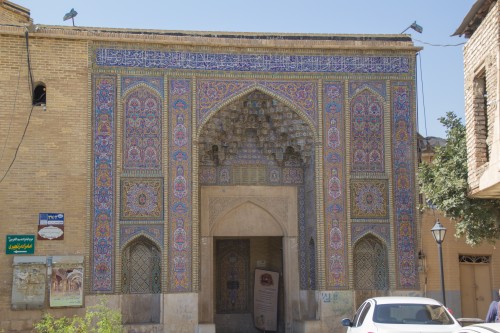
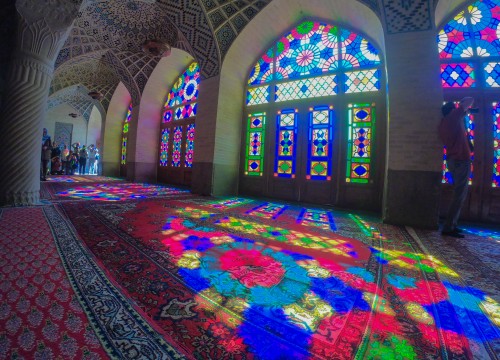



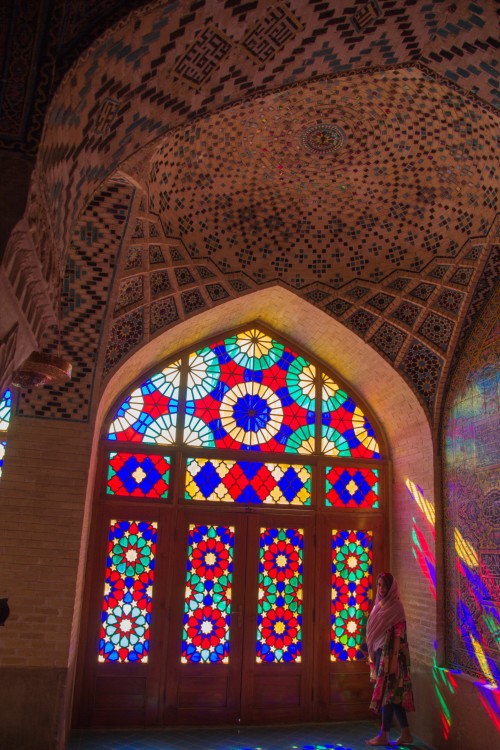
After what was basically a nap, we got up at 8am, and got cleaned up. Interestingly, the bathroom was full of purple tiles. We're in the middle of remodeling our new condominium, and have been looking for purple tiles everywhere, with only limited success, so it was ironic to see our bathroom in Shiraz full of them. Breakfast was pretty basic, and there weren't a lot of people in the restaurant.
 |
 |
 |
 |
 |
 |
We met Amin and Ehsan at 9. Our first stop was the Pink Mosque, known locally as Nasir-ol-Molk Mosque. It was constructed in the late 19th century, and is best known because of 1) its pink tilework (very unusual in Islam) and 2) its stained glass windows on the east side of its west prayer hall that turn the hall a kaleidoscope of color in the mornings. We weren't expecting many tourists, but we were wrong. There were probably as many people as we saw at the Pyramids in Giza in the spring of 2014. It was also much smaller than we expected - most of the photos on travel websites must be with very wide-angle lenses. Thankfully everyone was polite, letting others get the exact same picture in the northeast corner of the hall. The scenery might have looked better a little earlier in the day, but it was still very nice. After walking around inside for a bit, we went out to the courtyard and looked at some of the tilework and also the mihrab (prayer niche) on the south side.
 |
 |
 |
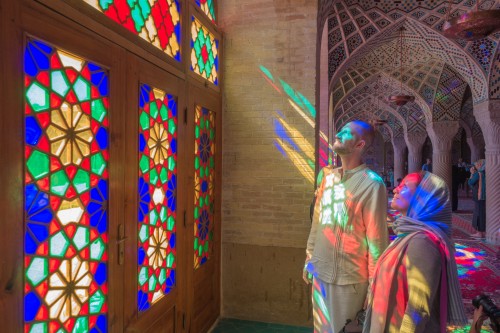 |
 |
The next stop was Eram Gardens. The main building there, plus much of the garden, was built during the 13th Century. It has undoubtedly evolved over time as various leaders utilized the gardens, and much of it was built/improved upon by Nasir-ol-Molk in the late 1900s. Now they are owned/run by nearby Shiraz University, and publicly accessible, although not many people were out and about today, with it being quite warm and very dry. Also, given that it is fall, not a whole lot of plants are blooming. So our stroll in the gardens wasn't for very long. There was a small museum/shop area, where we saw a bunch of turquoise and other gems, and also had a view of another building (not available to walk to) that had tilework with a cat-like being carrying a sword. Driving back across town, Justin spotted a random building with a large dome as we drove through one of the intersections. Amin mentioned that it was Ali Ibn Hamzeh shrine, and that although it wasn't on our itinerary, we could check it out later in the day.
 |
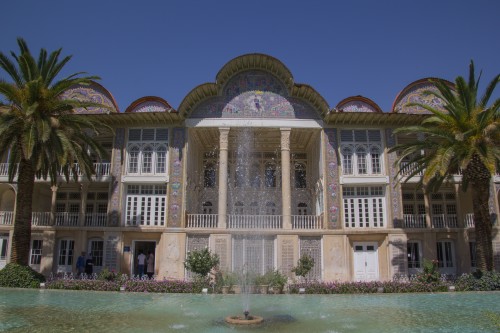 |
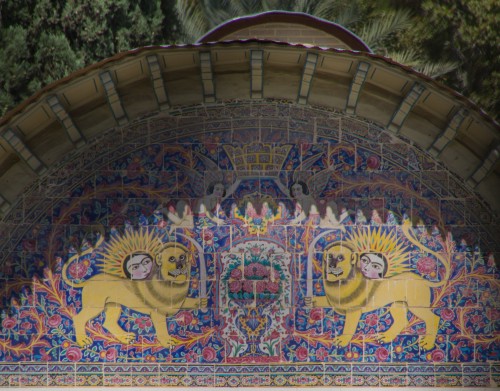 |
 |
Our next stop, however, was at the Hafez mausoleum. Hafez was a Pesian poet in the 1300s, who is revered in Iran and also throughout the world. A lot of his poems involved love, wine, and religious hypocrisy. Given that now in Iran alchohol is forbidden, and the country is a religious rather than secular government, we found it interesting that the most famous and revered poet discussed subject matter that is basically taboo. Hafez was born in Shiraz, and his tomb is a popular spot for people to visit, including young folks who visit and read his work when attempting to pick up on members of the opposite sex. Hafez was alive during the time of Timur, a ruler of vast territories in Central Asia during the 1300s, and Hafez was very popular with Timur. Hafez irritated Timur by stating "For the black mole on his cheek, I would give the cities of Samarkand and Bukhara." [Sick burn back in the day?] Timur responded that "By the blows of my well tempered sword I have conquered the greater part of the world to enlarge Samarkand and Bukhara, my capitals and residences; and you pitiful creature would exchange these two cities for a mole." Hafez replied "O Sovereign of the world; It is by the state of similar generosity that I have been reduced, as you see my present state of poverty." Timur was apparently very impressed with the witty response - we don't get it ourselves, but all that matter is Timur did - and any rift between Timur and Hafez was squashed.
 |
 |
 |
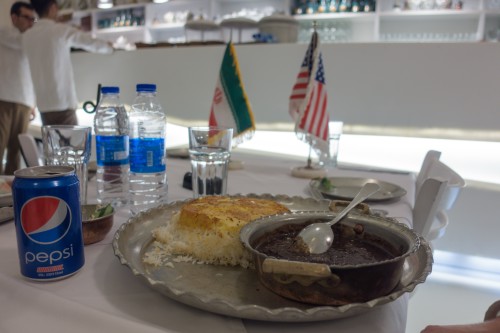 |
We left the Hafez mausoleum and headed back to the Ali Ibn Hamzeh shrine. It is a small facsimile of Shah Cheragh, a large mosque we were scheduled to see in the afternoon. Amin mentioned it was a good thing we spotted the shrine, since non-muslims not permitted in Shah Cheragh, but can visit the shrine. The inside was full of thousands (if not millions) of small pieces of glass, which made the whole interior look like a disco ball. It was really incredible, we'd never seen anything quite like it. We got background about the shrine (and Islam) from the resident Imam, and also Amin. The shrine was meant to honor the relative of the fourth Imam (there are twelve total) who was from Mashad. Behind Mashad and Isfahan, Shiraz is the third most holy city in Iran. We chatted with the Imam for about 15 minutes, discussing things over some tea, then headed out for lunch.
At lunch, Amin suggested a couple of things for us to eat that were specific to Iran. Justin got some fesenjan, a stew with chicken and walnuts and pomegranates. Crystal got tachin, which is a layered rice dish with meat (in this case lamb) and rice and yogurt. Both were fine, but not our favorite. Justin also got a couple Pepsis to wake up. We didn't know what to expect in Iran in terms of how "first world" it was, but it was far more developed than we expected. There were iPhones everywhere, Coke and Pepsi signs, new cars, and overall it easily could have been any Western nation from the looks of things. After doing some research, we realized that while sanctions may prevent companies from sending items directly to Iran, it's all pretty pointless because companies just send items to Dubai or other intermediary locations, who then ship the items on to Iran. When we left lunch, we went a nearby rug place that was famous for having rugs from nomadic tribes. The rugs were really, really phenomenal in terms of their design and craftsmanship. But they were way outside our price range, and not our type of decor either, particularly since we have the three dogs. We considered maybe getting one as a gift for someone, but logistically it would have been difficult. The prices, while far more than we wanted to pay, weren't that much given the number of hours to make them, making us wonder how the people who actually made the rugs could get by financially.
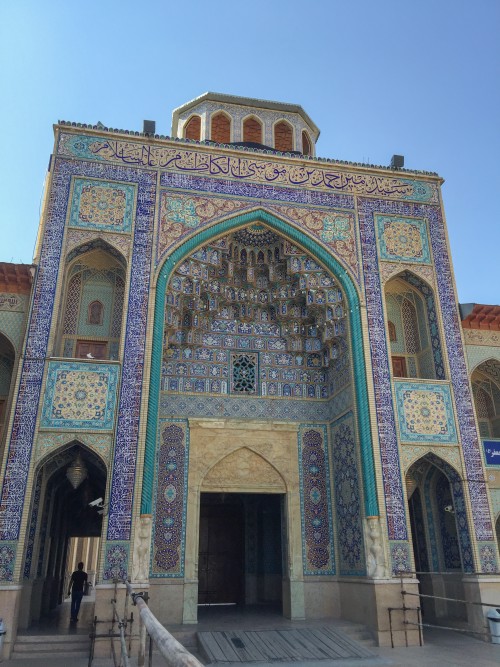 |
 |
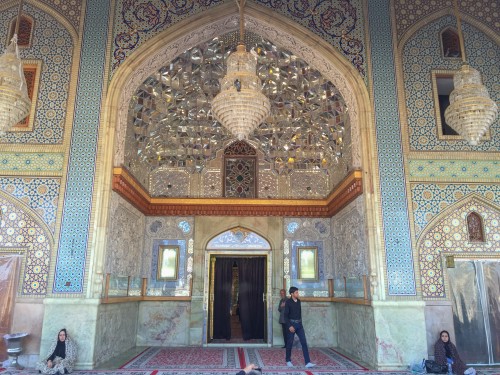 |
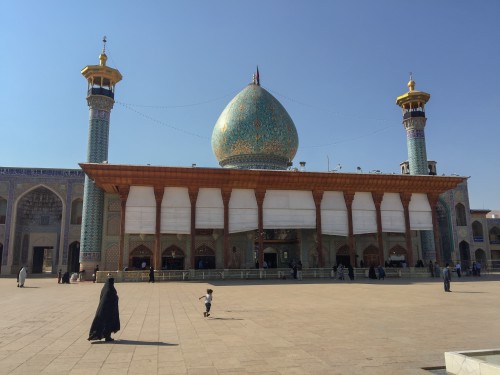 |
The next stop was Shah Cheragh Mosque, which we had been very excited to see. But as Amin told us, only Muslims could go inside the mosque, and even in the courtyard, only smartphone cameras were allowed. This was a major letdown, so it was very fortuitous that we were able to visit Ali Ibn Hamzeh shrine. Shah Cheragh is apparently a much larger version, but it's hard to tell from pictures how much bigger it is. We were with an escort who was showing us and some other tourists around, and apparently no one had told them that they couldn't go inside. They were not at all happy, and one person was voicing his displeasure to no avail. The whole complex was kind of odd, as there were barriers up all over the courtyard and walkways. Perhaps they would have made more sense on a busy day, but today it wasn't clear what exactly they were for. We basically ran through the complex for 10 minutes, then had to bounce. So again, thank goodness for the Ali Ibn Hamzeh shrine.
 |
 |
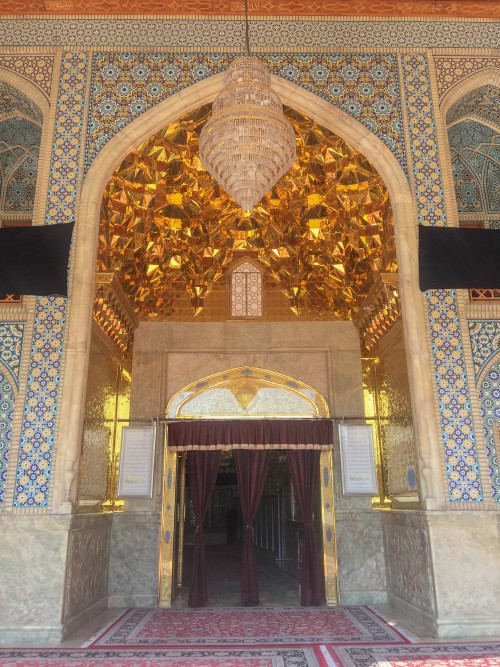 |
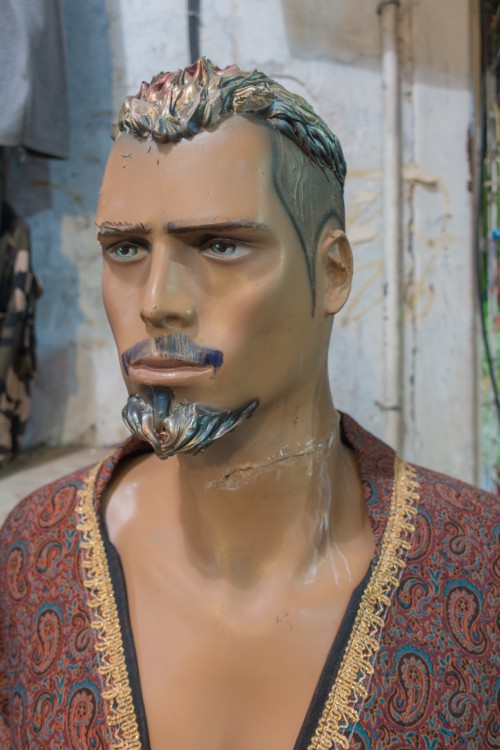 |
Leaving the Shah Cheragh complex, we walked through the local bazaar which was immediately next door. Lots of stalls were closed for siesta time, which is mid-afternoon. The bazaar was covered, sort of. There were these narrow corridors, with storefronts on either side, and a high ceiling that had been added well after the fact in the rare instances where it rains. We saw a fair amount of bird cages with parakeets, which was unexpected. We also saw a fair amount of beat-up mannequins, which we did expect, as we'd heard about it on the Amateur Traveler podcast episode on Iran. Apparently mannequins are hard to come by, so the ones currently in Iran have taken a lot of abuse, and have been repaired repeatedly, so are full of cracks, scratches, bad make up, etc.
 |
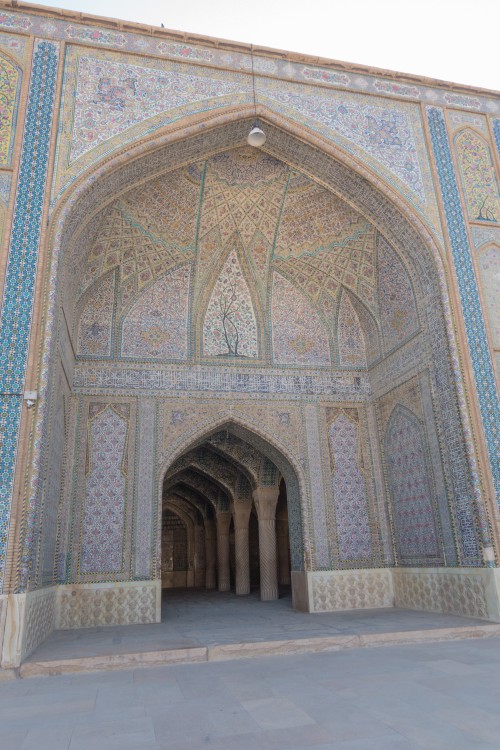 |
 |
 |
We came out of the bazaar right next to Vakil mosque. Unlike the other places we'd visited, there was no one there, at least at first. There were big stone columns in an indoor area near the mihrab, and it was vaguely reminescent of the Hippostyle Hall in Luxor, Egypt. Leaving the mosque, we walked past the Kharim Khan Citadel, which was across the street. It had its version of the Leaning Tower, with one of the corners of the citadel being at a very noticeable angle. We went back to the hotel from there, getting back a little after 4pm.
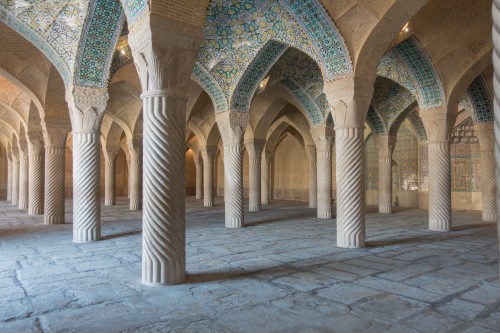 |
 |
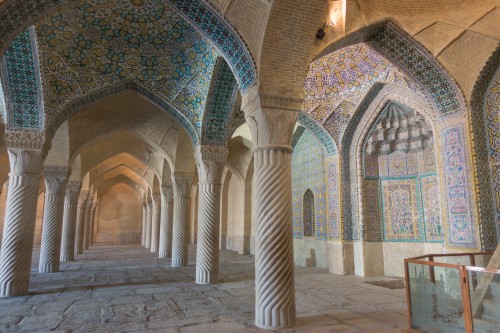 |
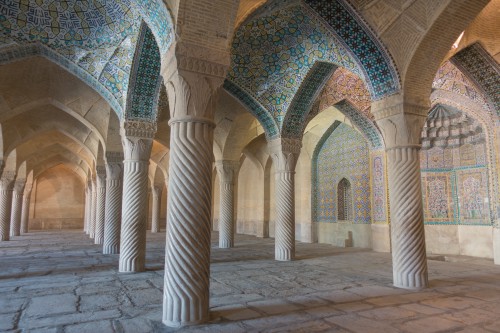 |
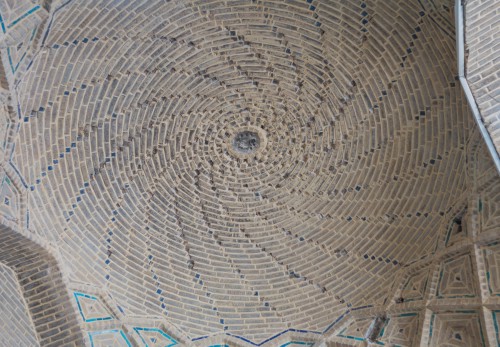 |
 |
We futzed around with our computers, trying to offload pictures and videos. The card reader on Justin's computer decided to stop working - not the greatest timing by any means. He finally managed to cludge something together, using Sony camera and cable that Crystal had brought for her GoPro. The pictures turned out nice, but didn't really do justice to the disco ball-type photos in the Ali Ibn Hamzeh shrine. We were trying to stay up as late as possible to help with jet lag, but Crystal needed to get a short nap in there. Justin caught up on the diary whilst Crystal slept. After she got up, we thought about dinner, but weren't really that hungry. So instead, we each read, trying to stay up as late as feasible. We also downloaded some podcasts, utilizing a wi-fi network that was just as fast as anything you'd expect in any major US city. We managed to make it just past 8pm until we crashed.
| Previous | Index | Next |